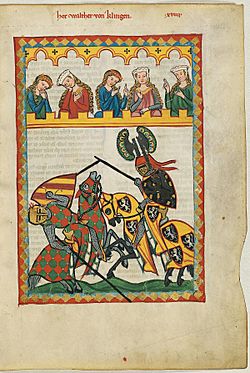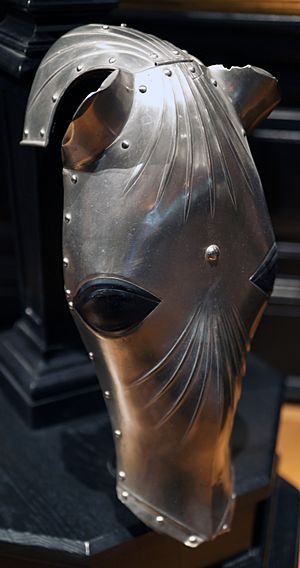Jousting facts for kids

Jousting was a popular sport in the Middle Ages. It involved two horsemen who rode towards each other at high speed. Each rider held a long wooden pole called a lance. The goal was to hit the opponent's shield or armor. If a rider could break their lance on the opponent or knock them off their horse, they scored points.
Jousting was often part of bigger events called tournaments. It was a way to practice skills needed for heavy cavalry battles. When the lances hit, the riders felt a force almost three times their body weight!
The word "jousting" comes from an old French word meaning "to meet." It became popular in English around the year 1300. At this time, it was a favorite sport among Anglo-Norman knights.
Jousting started as a military training exercise. Over time, it became a special sport. It stayed popular with rich and powerful families in England and Wales and Germany throughout the 1500s. However, in France, it stopped after King Henry II died in a jousting accident in 1559.
In England, jousting was a big part of celebrations. It was a highlight of the Accession Day tilts for Queen Elizabeth I and King James I. It was also part of the wedding celebrations for King Charles I.
Jousting became less popular in the 1600s. Other horse riding sports took its place. However, some forms of "equestrian skill-at-arms" still exist. These are horse riding skills without contact. Since the 1970s, there has been a small return of theatrical jousting. You can sometimes see jousting shows at Renaissance fairs or other historical events.
Horses Used for Jousting
The horses used for jousting were very important. The two main types were chargers and destriers. Chargers were medium-sized horses. They were trained to be quick and have lots of energy.
Destriers were larger horses. They were similar to today's Andalusian horse. However, they were not as big as modern farm horses.
Horse Care and Equipment
During a jousting event, grooms took care of the horses. They kept them in special tents. Horses wore fancy cloths called caparisons. These cloths showed the owner's family symbols.
Jousting horses also had special protection. Their heads were covered by a chanfron. This was an iron shield. It protected them from dangerous lance hits.
Riders used long-necked spurs to control their horses. These spurs helped them guide the horse with their legs stretched out. The saddle had a high back. This gave the rider a strong base when charging or when hit. Stirrups also helped riders stand up. This gave them more power when hitting with the lance.
Images for kids
-
A jousting scene from the late 1200s in the Codex Manesse.
-
The special jousting armor of John the Constant, from around 1500. The shield on his left shoulder is called an ecranche.
-
The fancy armor of Henry II, King of France, from around 1553-1555.
-
Armor made for King Henry VIII in 1544.
See also
 In Spanish: Justa para niños
In Spanish: Justa para niños










